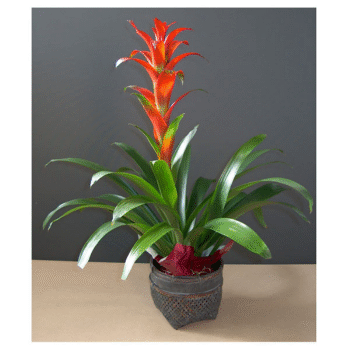Did You Know That Pineapples Are Pretty Bromeliads?
The Story of Pretty Bromeliads
A Little History
Bromeliads have been known since the days of Christopher Columbus. The people of the Carribean were found to be cultivating bromeliads and they were eating "pineapple". Yes, this was the first bromeliad discovered.
Columbus then took the pretty bromeliad to Spain and where it was subsequently grown. Since 1493 they have been transported into old world countries including India.

Most pretty bromeliads grow in the tropical and sub-tropical areas. This includes South America and especially Brazil. Other countries also in South America give rise to a number of varieties. In fact, there are 56 genera or families and about 2700 varieties.
Like orchid plants there are three types of plants. The terrestrial which grows in soil, the epiphyte which is the air plant and the saxiocolus which grows on rocks. This is very similar to what we see with orchids.
Today, most pineapples are a product of Hawaii and other tropical places. It might be of interest for you to know that the pineapple stems contain a protein known as bromelain. Bromelain is sometimes used as a meat tenderizer. It is also anecdotally attributed to have some effect with osteoarthritis.
Orchids and Pretty Bromeliads are Good Friends
Growth Patterns
The growth pattern of pretty bromeliads is around a tightly formed rosette of (usually fairly thin) leaves. The terrestrial bromeliads depend on the root system for nutrients especially water. The other types depend on the tightness of the leaves in the rosette to collect and hold the water. These can be supplemented by a trichome which is a thickened flake on the leaves. This allows the plant to have more area to absorb water. So these plants have a very efficient absorption system which is also similar to some of the orchid plants.
The leaves can vary from plant to plant. Some form a tight rosette with the leaves and others can have their leaves 180 degrees away from each other. The other purpose of the rosette is that it provides the plant with tiny chambers at the base of the leaves. Some bromeliad plants allow ants to live in these areas and the waste products of the ants gives additional fertilizer to the plant. Efficiency at its best.
Flower Stalk
The flower of the bromeliads is in the center of the plant. Some flowers can grow along a lengthy stalk while with others it could be short. The flower can be many on a stalk or a single one. These flowers are generally quite colorful.
Once a flower has been produced it rarely will produce another. What occurs is that it will produce a "pup" which is a baby bromeliad which will grow until it reaches a stage where is can root itself. It feeds from its mother and depends on being pollinated by flying insects like bees. The mother may survive for a generation of two but then will die off.
Did you know that the green leafy part of the top of a pineapple is a "baby" bromeliad? I hope to be adding information on bromeliads to this page so return soon for more fun bromelaid facts.
I include pretty bromeliads in this site as they often can grow in similar growing situations as many orchids.


